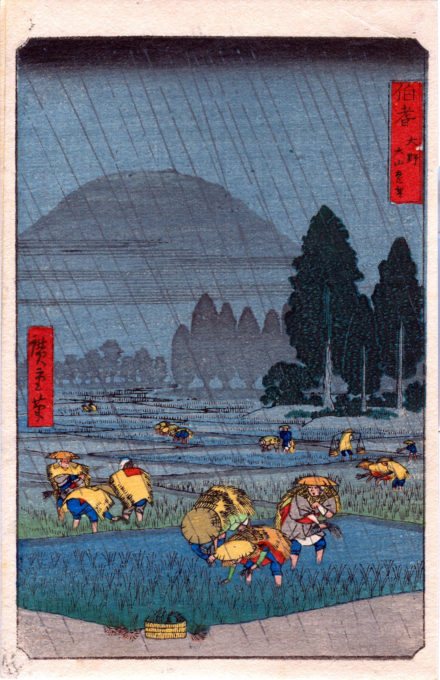
Reproduction of Hiroshige Ando’s ukiyo-e “Hôki Province: Ôno, Distant View of Mount Daisen (Mt. Oyama)”, published by S. Watanabe, c. 1930, from Hiroshige’s series Famous Places in the Sixty-odd Provinces [of Japan] first issued in 1853. Early morning view of farmers working the rice paddies in a rain storm.
Mount Daisen, once known as Ōkami-take — literally, ‘Mountain of the great god’ — was considered important for mountain ascetics for believers of the indigenous Shugendō sect, an amalgamation of beliefs, philosophies, doctrines and ritual systems drawn from local folk-religious practices, Shinto mountain worship and Buddhism. The Meiji government-enforced schism between Shinto and Buddhism resulted in its practice being forbidden in 1872, ruling that Shugendō was unacceptable because of its amalgamation of the two religions. But with the advent of religious freedom in Japan after World War II, Shugendō was revived.
See also:
“Night snow at Kanbara”, Hiroshige postcard reproduction, c. 1940.
Postcard reproduction (partial) of Hiroshige’s “Kinryūzan Temple in Asakusa”, Tokyo, c. 1940.
“Some prints of Medium and Post-card sizes are pictures reproduced from the masterpieces by Hiroshige, Hokusai and Utamarao, etc.
“[To reproduce] the old color prints, photographs are taken in diminished sizes and are pasted on woodblocks. Then black lines are engraved first, after which color-blocks are made from the sheets colored on the black lines. Because they are diminished to about one-tenth of the actual regular size, the engraving requires much skill and technique.
“By ‘reproductions’ we mean the masterpieces of the great ukiyoe (color–print) masters reprinted as nearly as possible like the originals, with the same technique and still as in olden times. Such reproductions serve the purpose of enabling us to appreciate the composition and coloring of the originals, which are usually very rare.”
– Watanabe Shozaburo
Publisher
S. Watanabe Gallery, Ginza, Tokyo
1962

